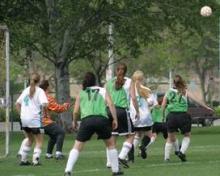The number of children and teenagers presenting at hospital emergency departments for evaluation of nonfatal traumatic brain injury related to sports and recreation activities grew by more than 60% between 2001 and 2009, according to a report from the Centers for Disease Control and Prevention released Oct. 6.
This significant increase of 62% over 8 years – from 153,375 emergency visits in 2001 to 248,418 in 2009 – is likely due to increasing awareness of the severity of traumatic brain injury (TBI) and the importance of prompt medical attention for these children and adolescents, according to CDC officials.
A primary strategy is to educate your patients and their families about prevention of TBIs, including concussions. Skills practice, strength and conditioning exercises, sportsmanship, and proper use of protective equipment are important strategies outlined in the report (MMWR 2011 Oct. 7;60:1337-42). Secondary measures include teaching parents, coaches, and others in your community about the signs and symptoms of TBI and how to respond appropriately to a suspected injury.
Physicians also play an essential role in deciding when an injured child or adolescent can return to his or her activity. An experienced health care provider should evaluate the patient and make the appropriate clearance call, according to the report.
"Return to play is a critical decision because children and adolescents are at increased risk for both repeat concussion during sports- and recreation-related activities and for long-term sequelae, delayed recovery, and cumulative consequences of multiple TBIs (e.g., increased severity of future TBIs and increased risk for depression and dementia)," the authors wrote.
Even though symptoms can initially appear mild, significant long-term effects can include impaired memory and learning, as well as changes to behavior and/or emotions. For these reasons, appropriate diagnosis, management, and education are critical.
An online course for health care professionals is the latest addition to the CDC Heads Up initiative, a program to educate specific audiences (such as parents, coaches, school nurses) about concussions and mild TBIs. The "Heads Up to Clinicians: Addressing Concussion in Sports Among Kids and Teens" was developed with support from the CDC Foundation and the National Football League.
Bicycling, football, playground activities, basketball, and soccer were associated with the overall greatest number of emergency department visits related to TBI in the report.
The riskiest activities varied by patient age and gender. For example, playground activities and bicycling led the list for boys and girls 9 years or younger. For children aged 10-19 years, there was a split by gender: football and bicycling were associated with the most TBIs among boys, whereas soccer, basketball, and bicycling were the most common culprits among girls.
Overall, boys accounted for 71% all sports- and recreation-related TBI visits to the ED over the 8 years of the study. Likewise, older children aged 10-19 years accounted for 71% of such ED visits.
The report also revealed activities for which TBI accounted for more than 10% of all associated injury visits to the ED. For example, TBIs accounted for 15% of horseback riding injuries; 11% of ice skating injuries; 11% of golfing injuries; 11% of all-terrain vehicle injuries; and 10% of tobogganing/sledding injuries.
The annual average number of 173,285 TBIs from 2001 to 2009 comprises almost 7% of the estimated 2.6 million sports- and recreation-related injuries treated each year among individuals aged 19 years and younger in the United States.
Researchers from the CDC Division of Unintentional Injury Prevention compiled the report based on data from NEISS-AIP (National Electronic Injury Surveillance System–All Injury Program). The U.S. Consumer Product Safety Commission operates the NEISS-AIP using a nationally representative sample of 66 hospitals.
The NEISS-AIP database tracks only hospital ED–reported injuries and does not include patients treated in other settings. This limitation underestimates the actual TBI rate from sports and recreation among children and adolescents, according to the CDC. In addition, TBIs are included in the data only if they are the principal diagnosis and primary body part injured. The inability to capture secondary TBIs is another limitation of the study.
Visit the CDC concussion pages for additional information and resources regarding TBI.
The authors of the CDC report had no relevant financial disclosures.


